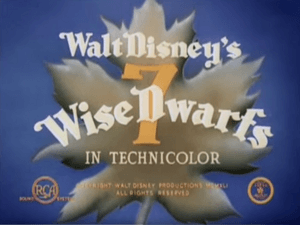7 Wise Dwarfs facts for kids
Quick facts for kids 7 Wise Dwarfs |
|
|---|---|

Title frame
|
|
| Directed by | Richard Lyford |
| Produced by | Walt Disney |
| Animation by | Dick Huemer |
| Studio | Walt Disney Studios |
| Distributed by |
|
| Color process | Technicolour |
| Running time | 3 minutes, 41 seconds |
| Country | Canada |
| Language | English |
7 Wise Dwarfs (also known as Seven Wise Dwarfs and Walt Disney's 7 Wise Dwarfs) is a short animated film from 1941. It was made by the Walt Disney Studios for the National Film Board of Canada. This film was released on December 12, 1941.
It was one of four films made to teach people in Canada about war bonds during World War II. War bonds were like special loans people could give to the government to help pay for the war. The film was directed by Richard Lyford. Pinto Colvig provided the voice for "Doc" in the film.
7 Wise Dwarfs features the Seven Dwarfs from Disney's famous movie, Snow White and the Seven Dwarfs. This short film came out four years after their first movie. A lot of the animation in this short film was actually reused from the 1937 Snow White movie. For example, Dopey often acts clumsy and confused for funny moments, just like he did in the original film.
Contents
What Happens in the Film?
The Seven Dwarfs are shown digging for gems. They march past Parliament Hill in Ottawa, Canada's capital city. Then, they hurry to a post office.
Dopey, however, gets locked out and goes to a nearby bank instead. All the dwarfs invest their gems in special Canadian War Savings Certificates. These certificates were a way to help fund the war. While they do this, the dwarfs sing a special version of their song "Heigh-Ho" from the original movie.
After this, the film shows quick scenes of war, each with a message. The new lyrics to their song talk about helping the war effort. They encourage people to buy war savings certificates. The song also uses a marketing phrase, "Five for Four." This meant that for every four dollars invested, people would get five dollars back later.
Meet the Characters
All seven of the famous Dwarfs appear in this film:
Film Song Lyrics
Here are the lyrics to the song the dwarfs sing in 7 Wise Dwarfs:
Hi-ho, Hi-ho, Hi-ho, Hi-ho, Hi-ho, Hi-ho, Hi-ho hum.
Heigh-ho, Heigh-ho we're the wisest dwarves we know (Whistle) Heigh-ho, Heigh-ho, Heigh-ho Heigh-ho, Heigh-ho It's off to buy we go We'll do our part with all our heart Heigh-ho, Heigh-ho, Heigh-ho Heigh-ho, Heigh-ho We all must help you know We'll win the war with five for four Heigh-ho, Heigh-ho, Heigh-ho Heigh-ho, Heigh-ho we'll help you find the gold We've done our part with all our heart Heigh-ho, Heigh-ho Heigh-ho, Heigh-ho, Heigh-Ho, Heigh-ho
This version of the song has fewer whistles than the original. It was meant to be like a "March of Freedom," encouraging people to support the war.
How the Film Was Made
In 1939, a big war started around the world. This war caused problems for Walt Disney Studios because they lost many of their customers in Europe. When France was invaded in 1940, Disney's next movie, Pinocchio, could only be released in Spanish and Portuguese. This was much fewer languages than their earlier films.
Because of these problems, Disney studios faced big financial difficulties. They had to cut jobs and reduce pay for the first time. To keep the studio running and making films, Walt Disney looked for money from outside sources. This way, he could keep his employees working.
On March 3, 1941, Walt Disney invited many representatives from national defense industries to a meeting. He wanted to offer his studio's help. He said he would make films for these industries "at cost, and without profit." He just wanted to help during this important time. The first training film they made was Four Methods of Flush Riveting for Lockheed Aircraft.
In response to Disney's offer, John Grierson, who led the National Film Board of Canada, made a deal with Disney. They agreed to make four animated films together. These films would help promote the Canadian War Savings Plan. They also ordered a training film for the Canadian Army, which later became Stop That Tank! (1942).
Where to Watch It Now
This short film was released on May 18, 2004. You can find it on a special collection called Walt Disney Treasures: Walt Disney on the Front Lines.

